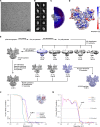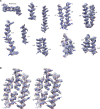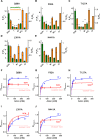Cryo-EM structures and functional characterization of murine Slc26a9 reveal mechanism of uncoupled chloride transport
- PMID: 31339488
- PMCID: PMC6656431
- DOI: 10.7554/eLife.46986
Cryo-EM structures and functional characterization of murine Slc26a9 reveal mechanism of uncoupled chloride transport
Abstract
The epithelial anion transporter SLC26A9 contributes to airway surface hydration and gastric acid production. Colocalizing with CFTR, SLC26A9 has been proposed as a target for the treatment of cystic fibrosis. To provide molecular details of its transport mechanism, we present cryo-EM structures and a functional characterization of murine Slc26a9. These structures define the general architecture of eukaryotic SLC26 family members and reveal an unusual mode of oligomerization which relies predominantly on the cytosolic STAS domain. Our data illustrates conformational transitions of Slc26a9, supporting a rapid alternate-access mechanism which mediates uncoupled chloride transport with negligible bicarbonate or sulfate permeability. The characterization of structure-guided mutants illuminates the properties of the ion transport path, including a selective anion binding site located in the center of a mobile module within the transmembrane domain. This study thus provides a structural foundation for the understanding of the entire SLC26 family and potentially facilitates their therapeutic exploitation.
Keywords: alternate access; chloride transport; cryo-EM; molecular biophysics; mouse; patch clamp; structural biology.
© 2019, Walter et al.
Conflict of interest statement
JW, MS, RD No competing interests declared
Figures

























Similar articles
-
SLC26A9 as a Potential Modifier and Therapeutic Target in Cystic Fibrosis Lung Disease.Biomolecules. 2022 Jan 25;12(2):202. doi: 10.3390/biom12020202. Biomolecules. 2022. PMID: 35204703 Free PMC article. Review.
-
The role of the STAS domain in SLC26A9 for chloride ion transporter function.Biophys J. 2024 Jun 18;123(12):1751-1762. doi: 10.1016/j.bpj.2024.05.018. Epub 2024 May 21. Biophys J. 2024. PMID: 38773769 Free PMC article.
-
Slc26a9 is inhibited by the R-region of the cystic fibrosis transmembrane conductance regulator via the STAS domain.J Biol Chem. 2009 Oct 9;284(41):28306-28318. doi: 10.1074/jbc.M109.001669. Epub 2009 Jul 30. J Biol Chem. 2009. PMID: 19643730 Free PMC article.
-
The molecular principles underlying diverse functions of the SLC26 family of proteins.J Biol Chem. 2024 May;300(5):107261. doi: 10.1016/j.jbc.2024.107261. Epub 2024 Apr 4. J Biol Chem. 2024. PMID: 38582450 Free PMC article.
-
Functional interaction of the cystic fibrosis transmembrane conductance regulator with members of the SLC26 family of anion transporters (SLC26A8 and SLC26A9): physiological and pathophysiological relevance.Int J Biochem Cell Biol. 2014 Jul;52:58-67. doi: 10.1016/j.biocel.2014.02.001. Epub 2014 Feb 14. Int J Biochem Cell Biol. 2014. PMID: 24530837 Review.
Cited by
-
SLC26 Anion Transporters.Handb Exp Pharmacol. 2024;283:319-360. doi: 10.1007/164_2023_698. Handb Exp Pharmacol. 2024. PMID: 37947907 Review.
-
Structural insights into the gating mechanism of human SLC26A9 mediated by its C-terminal sequence.Cell Discov. 2020 Aug 10;6:55. doi: 10.1038/s41421-020-00193-7. eCollection 2020. Cell Discov. 2020. PMID: 32818062 Free PMC article.
-
SLC26A9 deficiency causes gastric intraepithelial neoplasia in mice and aggressive gastric cancer in humans.Cell Oncol (Dordr). 2022 Jun;45(3):381-398. doi: 10.1007/s13402-022-00672-x. Epub 2022 Apr 14. Cell Oncol (Dordr). 2022. PMID: 35426084 Free PMC article.
-
SLC26A9 as a Potential Modifier and Therapeutic Target in Cystic Fibrosis Lung Disease.Biomolecules. 2022 Jan 25;12(2):202. doi: 10.3390/biom12020202. Biomolecules. 2022. PMID: 35204703 Free PMC article. Review.
-
Asymmetric pendrin homodimer reveals its molecular mechanism as anion exchanger.Nat Commun. 2023 May 25;14(1):3012. doi: 10.1038/s41467-023-38303-0. Nat Commun. 2023. PMID: 37230976 Free PMC article.
References
-
- Adams PD, Grosse-Kunstleve RW, Hung LW, Ioerger TR, McCoy AJ, Moriarty NW, Read RJ, Sacchettini JC, Sauter NK, Terwilliger TC. PHENIX: building new software for automated crystallographic structure determination. Acta Crystallographica Section D Biological Crystallography. 2002;58:1948–1954. doi: 10.1107/S0907444902016657. - DOI - PubMed
-
- Alguel Y, Amillis S, Leung J, Lambrinidis G, Capaldi S, Scull NJ, Craven G, Iwata S, Armstrong A, Mikros E, Diallinas G, Cameron AD, Byrne B. Structure of eukaryotic purine/H(+) symporter UapA suggests a role for homodimerization in transport activity. Nature Communications. 2016;7:11336. doi: 10.1038/ncomms11336. - DOI - PMC - PubMed
-
- Anagnostopoulou P, Riederer B, Duerr J, Michel S, Binia A, Agrawal R, Liu X, Kalitzki K, Xiao F, Chen M, Schatterny J, Hartmann D, Thum T, Kabesch M, Soleimani M, Seidler U, Mall MA. SLC26A9-mediated chloride secretion prevents mucus obstruction in airway inflammation. Journal of Clinical Investigation. 2012;122:3629–3634. doi: 10.1172/JCI60429. - DOI - PMC - PubMed
-
- Arakawa T, Kobayashi-Yurugi T, Alguel Y, Iwanari H, Hatae H, Iwata M, Abe Y, Hino T, Ikeda-Suno C, Kuma H, Kang D, Murata T, Hamakubo T, Cameron AD, Kobayashi T, Hamasaki N, Iwata S. Crystal structure of the anion exchanger domain of human erythrocyte band 3. Science. 2015;350:680–684. doi: 10.1126/science.aaa4335. - DOI - PubMed
Publication types
MeSH terms
Substances
Associated data
- Actions
- Actions
- Actions
- Actions
- Actions
Grants and funding
LinkOut - more resources
Full Text Sources
Other Literature Sources
Molecular Biology Databases
Research Materials

